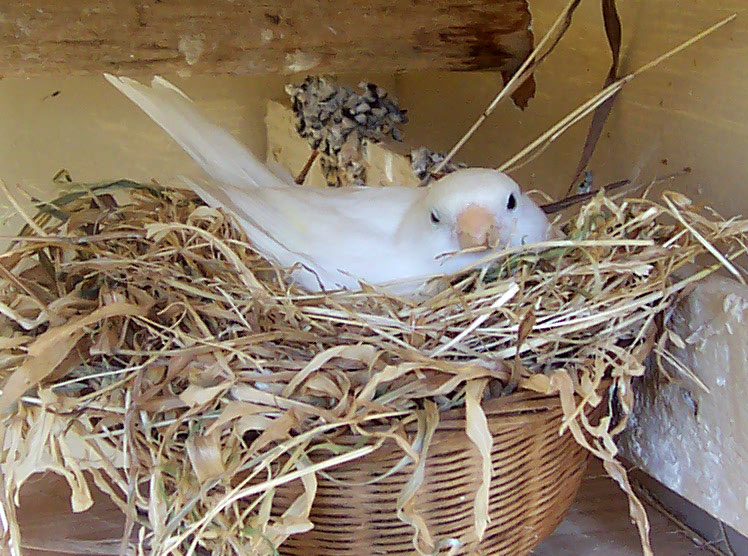| New Photos | Animal News | Animal Sounds | Animal Movies | Upload Photo | Copyright | Korean |
|---|
| Funny Animal Photos | Monsters in Animalia | Wiki Articles Fun Facts about Animals | Links | Home | Mobile A.P.A. |
|---|
| Image Info | Original File Name: White Domestic Canary_nesting-Serinus canaria.jpg Resolution: 748x556 File Size: 146847 Bytes Upload Time: 2008:01:16 10:34:28 | |
| Author | Name (E-mail): Unknown | |
| Subject | Domestic Canary (Serinus canaria) - Wiki | |
 |
| Email : E-Card | Poster | Web Master Delete Edit Info Admin |
| Description | Domestic Canary (Serinus canaria) - Wiki
Domestic Canary
The Canary is a domesticated form of the Wild Canary, (Serinus canaria) a small songbird in the finch family originating from Madeira and the Canary Islands. Canaries were first bred in captivity in the 1600s. They were brought over by Spanish sailors to Europe. Monks started breeding them and only sold the males (which sing). This kept the birds in short supply and drove the price up. Eventually Italians obtained hens and were able to breed the birds themselves. This made them very popular and resulted in many breeds arising and the birds being bred all over Europe. The same occurred in England. First the birds were only owned by the rich but eventually the local citizens started to breed them and, again, they became very popular. Many breeds arose through selective breeding. Miner's canaries were used as an early form of warning system for the detection of poisonous but odourless carbon monoxide in mines. Three or more canaries (or other small birds with high metabolism) were taken down new shafts, and if one or more exhibited abnormal behavior, the parties determined that the shaft was unsafe. Varieties Canaries are generally divided into three main groups: Colorbred Canaries (bred for their many color mutations - Ino, Eumo, Satinette, Bronze, Ivory, Onyx, Mosaic, Brown, etc.), Type Canaries (bred for their shape and conformation - Border, Fife, Gloster, Gibber Italicus, Raza Espa??ola, Berner, Lancashire, Yorkshire, Norwich, etc.), and Song Canaries (bred for their unique and specific song patterns - Spanish Timbrado, Roller, Waterslager (also known as "Malinois"), American Singer, Russian Singer, Persian Singer). Canaries are judged in competitions every fall. Shows generally begin in October and November after the breeding season ends. Birds can only be shown by the person who raised them. They all have unique bands on their legs that indicate the year of birth, the unique band number, the club to which the breeder belongs. Some song-breed canaries are judged later in the year (January). There are many canary bird shows all over the world. The world show (C.O.M.) is held in Europe each year and attracts thousands of breeders. As many as 20,000 birds are brought for competition. Miner's canary Canaries were once regularly used in coal mining as an early warning system. Toxic gases such as carbon monoxide and methane in the mine would kill the bird before affecting the miners. Because canaries tend to sing much of the time, they provided both a visual and audible cue in this respect. The use of so called miner's canaries in British mines was phased out as recently as 1987. By analogy, the term climate canary is used to refer to a species that is affected by an environmental danger prior to other species, thus serving as an early warning system for the other species with regard to the danger. Use in research Canaries have been extensively used in research to study neurogenesis, or the birth of new neurons in the adult brain, and also for basic research in order to undestand how songbirds encode and produce song. Thus, canaries have served as model species for discovering how the vertebrate brain learns, consolidates memories, and recalls produces coordinated motor movements. Fernando Nottebohm, a professor at The Rockefeller University detailed the brain structures and pathways that are involved in the production of bird song. Trivia Canaries have been depicted in cartoons from the middle 20th century as being harassed by domestic cats; the most famous cartoon canary is Warner Brothers' "Tweety Bird". Norwich City, an English football team is nicknamed 'The Canaries' due to the city once being a famous centre for breeding and export of the birds. The club adopted the colours of yellow and green in homage. http://en.wikipedia.org/wiki/Domestic_Canary
| |||
| Copyright Info | AnimmalPicturesArchive.com does not have the copyright for this image. This photograph or artwork is copyright by the photographer or the original artist. If you are to use this photograph, please contact the copyright owner or the poster. |
|
|
|
| |||||||
| CopyLeft © since 1995, Animal Pictures Archive. All rights may be reserved. | ||||||||
Stats